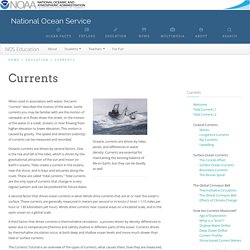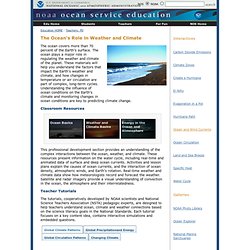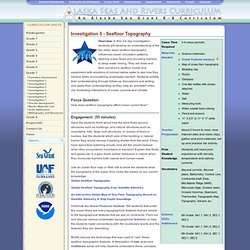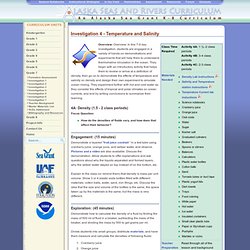

Science with NOAA Research: Ocean Currents. Climate and Currents Lesson Plan. In Deep Water: Will Essential Ocean Currents Be Altered by Climate Change? [Slide Show] Every second, a vast quantity of cold, dense seawater equal to six times the combined flow of every land river on Earth streams over an ocean-floor ridge that stretches between Greenland and Scotland.
![In Deep Water: Will Essential Ocean Currents Be Altered by Climate Change? [Slide Show]](http://cdn.pearltrees.com/s/pic/th/essential-currents-scientific-76202340)
This deep southbound current, flowing from the Norwegian, Iceland and Greenland seas into the North Atlantic, is the lower limb of the Gulf Stream and its northerly extension, a great conveyor belt of ocean heat and salt that transports warm tropical water north from the equator. Most climate change models predict global warming will slow these flows, in part by altering a key component of the Atlantic's circulation, called deep-water formation. If that happens, northern Europe will cool—or warm less severely—as the rest of the globe swelters. Oceanographers have been using moored acoustic Doppler current profilers and temperature sensors for the last decade to measure deep water as it pours over the Greenland–Scotland Ridge on its way south.
But it's not that simple. Ocean Currents and Climate. Mass flows of water, or currents, are essential to understanding how heat energy moves between the Earth’s water bodies, landmasses, and atmosphere.

NOAA: Currents. Oceanic currents are driven by tides, winds, and differences in water density.

Currents are essential for maintaining the existing balance of life on Earth, but they can be deadly as well. When used in association with water, the term "current" describes the motion of the water. Some currents you may be familiar with are the motion of rainwater as it flows down the street, or the motion of the water in a creek, stream, or river flowing from higher elevation to lower elevation. This motion is caused by gravity. Oceans, Weather, and Climate. The ocean covers more than 70 percent of the Earth’s surface.

The ocean plays a major role in regulating the weather and climate of the planet. These materials will help you understand the factors that impact the Earth's weather and climate, and how changes in temperature or air circulation are part of complex, long-term cycles. Understanding the influence of ocean conditions on the Earth’s climate and monitoring changes in ocean conditions are key to predicting climate change. Classroom Resources This professional development section provides an understanding of the complex interactions between the ocean, weather, and climate.
Teacher Tutorials The tutorials, cooperatively developed by NOAA scientists and National Science Teachers Association (NSTA) pedagogic experts, are designed to help teachers understand ocean, climate and weather connections based on the science literacy goals in the National Standards. Global Climate Patterns. Ocean Currents and Global Climate Lessons. Investigation 5 - Seafloor Topography. Overview: In this 3-4 day investigation, students will develop an understanding of the two basic ways seafloor topography influences ocean circulation patterns, steering ocean flows and providing barriers to deep water mixing.

They will draw and then construct a seafloor model and experiment with solutions of colored saline water to see how they behave when encountering underwater barriers. Students solidify their understanding through follow-up discussions and writing, and apply their understanding as they view an animated video clip illustrating interactions of ocean currents and climate. Focus Question: How does seafloor topography affect ocean current flow? Engagement: (55 minutes) Have the students think about how the wind flows around structures such as buildings, and natural structures such as mountains, hills, large rock structures, or clumps of trees or bushes. Global Seafloor Topography from Satellite Altimetry. The Habitable Planet: Atmosphere. Investigation 2 - Weather and Circulation Systems.
Overview: In this 5-day investigation, students develop an understanding that the large ocean circulations affecting Alaska mimic major weather patterns.

They begin by creating and observing wave and riffle patterns and motions of objects in a tub. They plot possible current patterns on their map and organize meteorological data to determine how well wind patterns match their predictions. After a lecture/discussion to learn more about currents and weather patterns, they role-play shipping captains who must consider wind and current patterns to find the quickest route from Seattle to Anchorage. They finish up with a discussion that takes them back to the question about the toys’ movements. Focus Question: Tracking a Hurricane. Hurricane Tracking from a Safe Distance The Story You are a hurricane expert.
Your job is to track approaching hurricanes, and alert the public about possible danger. If your area could be hit by a hurricane in the next 24 to 36 hours, it is your job to announce a hurricane watch. When a hurricane is probably going to hit your area in 24 hours or less, you announce a hurricane warning. You are the hurricane expert for New Orleans, Louisiana. Procedure Since this storm may be a threat to New Orleans, you decide to plot its path on a hurricane tracking map. Track A Hurricane Activity. Return to activity index Hurricanes are born of tropical waters where trade winds meet and make air swirl.

They begin like developing thunderstorms, but the warm ocean gives hurricanes unlimited energy and moisture. A full-blown hurricane is made of many bands of thunderstorms circling around a calm eye. Hurricanes and Their Tracks. Lab 5: It's All Connected: Global Circulation. The lab activity described here was adapted by Erin Bardar of TERC for the EarthLabs project.

Summary and Learning Objectives Students are introduced to the global circulation patterns of the atmosphere and the oceans, and investigate how those circulation patterns might influence their local region. Students use computer models to test predictions of ocean currents. After completing this investigation, students should be able to: JetStream - An Online School for Weather. Investigation 4 - Temperature and Salinity.
Overview: Overview: In this 7-9 day investigation, students are engaged in a variety of hands-on demonstrations and experiments that will help them to understand thermohaline circulation in the ocean.

They begin with an introductory activity that helps them to review or arrive at a definition of density, then go on to demonstrate the effects of temperature and salinity on density and design their own experiment to simulate ocean mixing. They experiment further with hot and cold water as they consider the effects of tropical and polar climates on ocean currents, and end by writing conclusions to summarize their learning. 4A: Density (1.5 - 2 class periods) Focus Question: Season, Lunar Cycle, and Tides Unit Plan. Moon Phases. What Causes The Phases Of The Moon? The following image is from the Visual Dictionary Online. It says, "Changes in the Moon’s appearance over the course of a month; result from the movement of the Moon in relation to the Sun, as seen from Earth. " The next image is from moonconnection.com, and it's a little more descriptive. The illustration may look a little complex at first, but it's easy to explain.
Sunlight is shown coming in from the right. Examine the phases of the moon from Earth and space. Learn About The Phases Of The Moon. MoonMatch. LUNAR PHASES. Oreo Moon Phases. Moon Articles. Small Moon Big Sun. ECLIPSES. Lab - Phases and Eclipses. Modeling Eclipses. Build a Solar Eclipse Viewer. NASA - Ocean Motion. For centuries, mariners have relied on ocean surface currents. Explorers rode them to discover new lands. Merchants counted on them to speed the transport of goods to market. Today understanding ocean surface currents is as important as ever. People study currents to select the most fuel efficient path for ships, win sailboat races, track pollution such as oil spills, assist in search and rescue operations and determine the best location for catching fish.
Yet ocean surface currents also play a larger role in shaping our world. Other than the sun, the ocean is the most important force affecting Earth’s climate. Understanding surface currents is also important for understanding the ecology of life in the ocean. All of human understanding is based – at some level – on observation. Scientists are developing increasingly sophisticated computer models to study weather variability. Lunar and Solar Tides. Tides cause daily changes in water level in many coastal areas. Factors such as local topography and weather contribute to the timing and height of tides, but the primary reason for tides is the gravitational attraction between liquid water on the Earth and the Moon.
All objects on Earth experience tidal forces. However, the effect is most pronounced with water because, as a liquid, it is more easily deformed by gravity when compared to solid objects. Investigating the Causes of Tides. Tides. Islands Live Teacher's Guide - Tides & Lunar Cycles. Tides & Lunar Cycles Summary. Investigation 3 - Waves and Tides. Overview: In this 7-10 day investigation, students develop an understanding of waves and tides and their motion through discussion, demonstration, and hands-on investigation. They demonstrate wave motion in containers, and create marigrams to show local tide data and to compare tide patterns from different parts of the world. They use their knowledge to consider whether waves or tides could account for the movement of the bath toys to their final locations.
Activity 3A: Waves in the Water. Tides Simulation. Virtual Lab - The Moon and Tides. Plotting Ocean Tides. How Does the Moon Affect the Tides? TidesActivity. Predicting the Tides. Moon Phases, Tides, and D-Day. The Tides of War. Eisenhower and D-Day. HowStuffWorks - Tidal Currents. Tidal currents, as their name suggests, are generated by tides.
Learn about Tides, Ocean Currents and Waves. Great Pacific Garbage Patch. NOAA Tides and Currents Map. Tide Predictions. Explore: Tides and Currents.